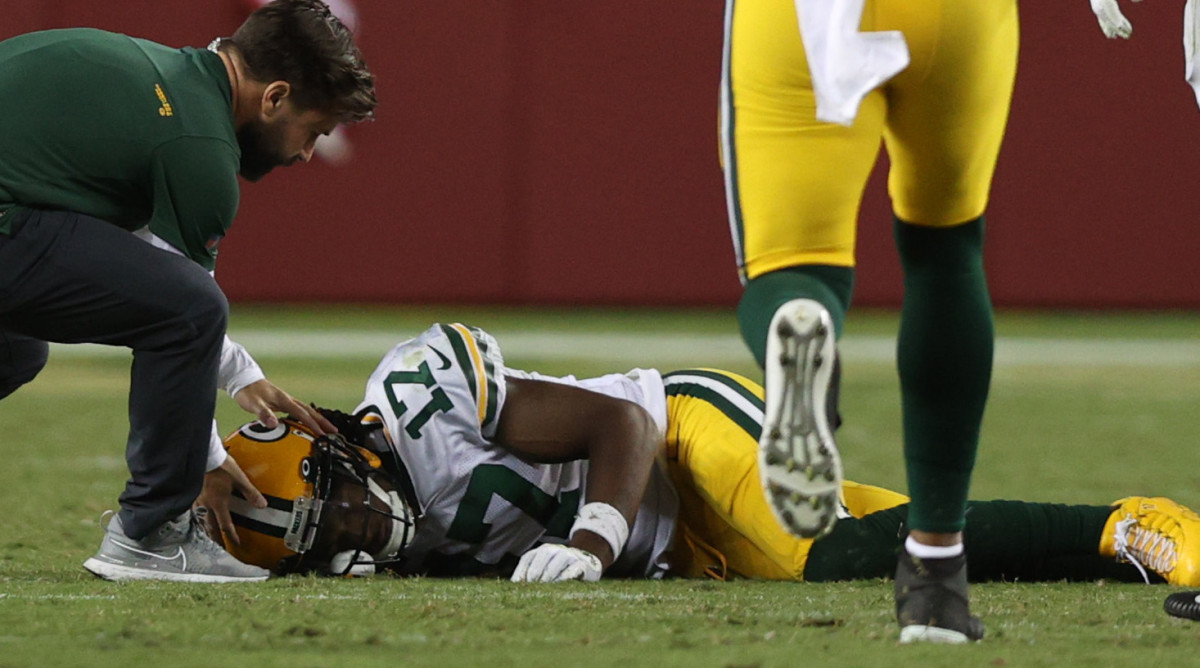Concussion Tests Merit More Than Just a Spare Moment
What Aaron Rodgers did to the 49ers’ defense at the end of Sunday's 30-28 win, carving up their secondary like an Itamae during an open kitchen with a food critic sitting front row, was the kind of skill mastery that mesmerizes. Here is a human being curving a football around expertly designed coverages, twice hitting Davante Adams to get his team within field goal range, spiking the ball with three seconds remaining and pumping his fist as he walked off the field, setting the stage for a game-winning field goal.
But how many of us were asking ourselves at that point why Adams was on the field at all, or how he must have been feeling about six game minutes after being leveled by one of the most egregious non-called helmet-to-helmet collisions we've seen since the NFL became legally obligated to pay more attention to such things? We know it’s hard to remember with all the flashing lights and music and lead changes, the kinds of things that teeter our fantasy football scores and draw us collectively from the Man Behind the Curtain. But at the 7:48 mark in the fourth quarter, Adams took a shot from the helmet of 49ers safety Jimmie Ward (Ward, after the game, called it a clean hit, for the record). Adams’s head snapped back like one of those crash test mannequins we see testing airbags and Adams laid on the field for a while with his head on the turf before walking to the sideline.

It was serious enough that reporters on the scene were looking for motion in his feet or other extremities. Sadly it’s an instinct at this point since it happens so often, though this is not a referendum on the state of the game. Put down your pitchforks; we’re not coming for physicality and understand the ethical tradeoff we make in enjoying this sport. Big hits are part of the deal. This is going to happen when you’re asking people running at Olympic sprinter speeds to try and change direction at the last second.
The problem is when Adams disappears for one play and a timeout, returning to the field for third down like nothing happened. His time in the blue tent didn’t feel long enough to get a non-invasive COVID test, never mind a full spectrum evaluation of his mental state and faculties before he rejoined the huddle. This seems to happen from time to time. A pretty swift YouTube video explaining the process takes about seven and a half minutes to get through. As my colleague, Jenny Vrentas, brought up during our latest episode of the MMQB podcast, Doctors have to check for “no go” features, they have to ask the player what happened on the play that earned him a trip to the blue tent, they have to ask him if he has a headache, if he’s confused or dizzy, they have to monitor his speech for any slurring, they have to ask him questions to gauge his orientation, like where he’s currently playing, what quarter it is and when the last time a team scored was. They have to do all this inside a tiny tent surrounded by tens of thousands of screaming people.
For as many games as the concussion protocol seems to step up and make the proper interventions—in the playoffs last year, for example, both Patrick Mahomes and Lamar Jackson missed real, noticeable game time to evaluate potential symptoms—there are others where the speed at which a player returns feels less efficient and more … icky.
After the game, Adams said he got through the moment because “I’m different,” and that his chest was the real issue after Ward's hit knocked the wind out of him. That may very well be true. This is not an attempt to criticize Adams for a decision he made to return to play or claim to know more about his personal health than he does. This is merely a request for a little more time. A pause. A real moment to make those of us who aren’t so easily distracted feel like everything is buttoned up.
Of course, Adams’s late-game theatrics on an ensuing drive could help us forget the moment even happened. As we get wrapped up in it all, a flicker of the memory we had about the hit returns to consciousness and somehow gets repackaged into a narrative about toughness. Cris Collinsworth declared Adams “fine” on the broadcast having seen only the scant evidence that we all saw. Adams got hit. He laid on the turf for an uncomfortably long time. He got checked out, then he made a great catch a few minutes later.
Great, right?
More NFL Coverage:
• Week 3 NFL Takeaways: Justin Tucker Is the Ultimate Weapon
• Early Losses a Warning Sign for the Chiefs
• Big Ben a Convenient Target, but Steelers Have Larger Issues
• WFT Kicker Dustin Hopkins Recovers Own Kickoff
